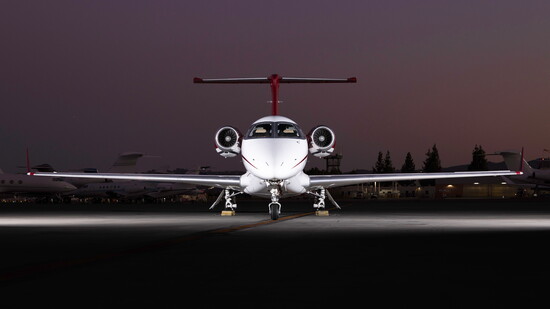Private aviation is more than just a mode of transport—it’s a statement of efficiency, exclusivity, and unparalleled luxury. The world of high-net-worth individuals and corporate executives continues to evolve, with demand for bespoke aircraft reaching new heights. Whether it’s a Gulfstream G700, a fully customized Bombardier Global 7500, or a technologically advanced Praetor 600, private jets remain the ultimate asset in luxury travel.
As the president of Hopkinson Luxury Aircraft Sales, a Scottsdale-based aircraft acquisition and sales firm, I work with Fortune 500 companies, high-net-worth individuals, and aviation enthusiasts to help them secure and personalize their aircraft. Here are the trends shaping the industry today and the future of private aviation.
The Most Coveted Private Jets in the World
Private jets are defined by their performance, range, and comfort. The Phenom 300E continues to dominate the light jet category with its sleek design, fuel efficiency, and versatility. Meanwhile, the Praetor 500 and 600 are highly sought after in the super mid-size segment, offering stand-up six-foot cabins and transcontinental range. Historically, the Challenger 3500 has led in volume, but demand is growing for jets that can travel coast-to-coast or across the Atlantic without refueling.
At the ultra-high-end, wide-body, long-range aircraft like the Gulfstream G500/G600 and Dassault Falcon 6X are setting new benchmarks in capability and comfort. These jets are so exclusive that pre-owned inventory is scarce, with wait times stretching beyond two years. The Falcon 6X and upcoming 10X, with their unprecedented 6’6” cabin height, redefine spaciousness in private aviation.
The Shift in Celebrity & Billionaire Jet Ownership
Luxury aviation has always been a playground for the ultra-wealthy, but recent years have seen celebrities and billionaires upgrade their aircraft for even greater range and sophistication. Michael Jordan’s transition from a Gulfstream 550 to a 650ER reflects this trend, as does Kim Kardashian’s acquisition of the same model. Meanwhile, Kylie Jenner owns a Global 7500, the pinnacle of long-range private jets.
With the arrival of the Gulfstream G700, figures like Oprah Winfrey and the Fertitta brothers are expected to make the leap into the next generation of luxury aviation, pushing the boundaries of what’s possible in private travel.
The Sustainability Shift in Private Aviation
The aviation industry is under increasing scrutiny for its environmental impact, and luxury jets are no exception. The adoption of Sustainable Aviation Fuel (SAF) is growing, and private jets continue to lead in technological advancements that improve aerodynamics and fuel efficiency. These innovations aren’t just about reducing emissions—they also enhance range, allowing aircraft to reach new destinations without refueling.
Outside of cutting-edge military aircraft, today’s private jets are the most advanced machines in the sky, blending technology, performance, and sustainability like never before.
Customization: The Art of Personalization in Private Jets
Owning a private jet is about more than just speed and range—it’s about creating a bespoke, flying sanctuary. The level of customization available today is staggering, from rare wood veneers and designer textiles to state-of-the-art entertainment systems and immersive lighting.
Some of the most extravagant requests I’ve seen include:
- Fully equipped hideaway bars for onboard mixology
- Advanced soundproofing and lower cabin altitudes to combat jet lag
- Starlink satellite connectivity for seamless, high-speed internet
- In-flight showers—a game-changer for arriving refreshed after long-haul flights
Why Private Jets Are the Ultimate Status Symbol
Private jets give their owners control over time. Unlike any other asset, an aircraft eliminates inefficiencies in travel, allowing direct access to locations that commercial airlines simply don’t serve.
A private jet is not just about exclusivity; it’s a tool that enables high achievers to maximize their productivity, whether by holding meetings mid-flight or simply arriving at a destination well-rested and ready for business.
The Competition for Exclusive Aircraft
Unlike limited-edition supercars or rare watches, private jets rarely go out of style. But for true aviation aficionados, the rarest jets are meticulously restored warbirds or historical aircraft that tell a unique story.
For those in the market for something brand new, custom interiors and exterior paint jobs have become the ultimate personalization flex. Some prefer to make a bold statement with vibrant colors and unique branding, while others opt for understated, stealth wealth designs that offer the ultimate discretion.
What’s Next for Luxury Aviation?
Looking ahead, the demand for private jets will continue to be driven by efficiency, speed, and connectivity. Advances in fuel efficiency and materials will allow for even greater range, while high-speed connectivity will transform in-flight experiences, making it possible to seamlessly work and stream entertainment at 40,000 feet.
Since the pandemic, demand for private aviation has soared, with more individuals and businesses opting for private travel over commercial airlines. While flight hours have slightly declined in 2024, global demand remains far higher than pre-pandemic levels. The driving factor? Commercial airline disruptions and limited destination options, pushing more high-net-worth individuals toward private jet ownership.
Fractional Ownership vs. Full Ownership
Private jet ownership is not a one-size-fits-all investment. The decision comes down to flight hours and travel frequency:
- Under 50 hours per year: Charter is the best option.
- 50–100 hours per year: Fractional ownership (shared jet access) may make sense.
- 100+ hours per year: Full ownership becomes more practical, offering complete flexibility and customization.
For those who fly over 150 hours annually, full ownership is typically the best solution, with some travelers opting to own a primary jet while chartering larger aircraft for international trips.
hopkinson.aero
